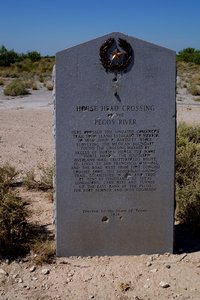Advertisement
Published: September 10th 2019

 HORSE HEAD CROSSING MARKER
HORSE HEAD CROSSING MARKER
Of course the sign is all shot to pieces. Is, after all, in West Texas.When Ben Franklin said, “You can lead a horse to water, but you can’t make him drink” surely he was talking about the horses in West Texas. The Pecos River flows through there and the water can be quite alkaline during the drier times of year when horses are most thirsty. Sometimes the water is so bitter that the horses won’t drink it and they perish from their thirst while the river gurgles merrily along to the gulf. In 1849 a fellow named Randolph Barnes Marcy was mapping the area for the army and he noted that there was a safe crossing there due to a gravel bottom in the river bed. He also noticed that there were the remains of several dead horses in the area. It became known as Horsehead Crossing in a book that Marcy later wrote:
The Prairie Traveler: A Handbook for Overland Expeditions, with Maps, Illustrations, and Itineraries of the Principal Routes between the Mississippi and the Pacific. The book was popular among folks going to California during the Gold Rush. The crossing was subsequently used by the army, by the stage coaches, and by every cow that went up the Goodnight/Loving Trail.

 THE CROSSING WAS SAFE, BUT THE WATER WAS ALKALINE.
THE CROSSING WAS SAFE, BUT THE WATER WAS ALKALINE.
Coyotes who drink from the river would poop white.In its day Horsehead Crossing was a big deal among all who travelled through West Texas. The railroads bypassed it though and it fell out of use. What was once a lively place is now just a dim memory. Of course the Comanche had been using that crossing to raid into Mexico since time began. Some of those dead horses might have been taken from Mexico by the Comanche and were just abandoned there when they could no longer keep up the brisk pace of hurried travel. Marcy pretty much has faded into history too. He stayed in the Army after the War with Mexico and raised a daughter who married General George B. McClellan. During the Civil War Randolph became George’s chief of staff. Eventually he retired from the army as a major general and is buried in Trenton, NJ. His book is still available if you should care to read it.
Advertisement
Tot: 0.101s; Tpl: 0.013s; cc: 13; qc: 36; dbt: 0.0608s; 1; m:domysql w:travelblog (10.17.0.13); sld: 1;
; mem: 1mb

 HORSE HEAD CROSSING MARKER
HORSE HEAD CROSSING MARKER
 THE CROSSING WAS SAFE, BUT THE WATER WAS ALKALINE.
THE CROSSING WAS SAFE, BUT THE WATER WAS ALKALINE.